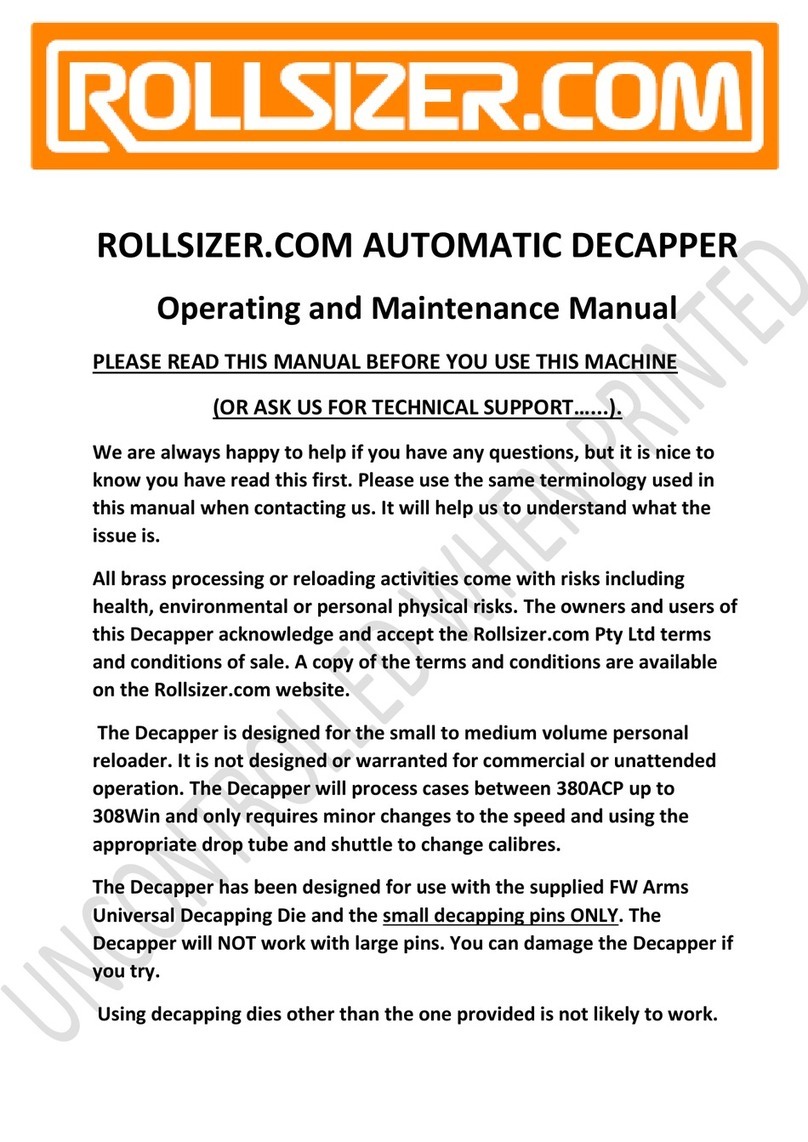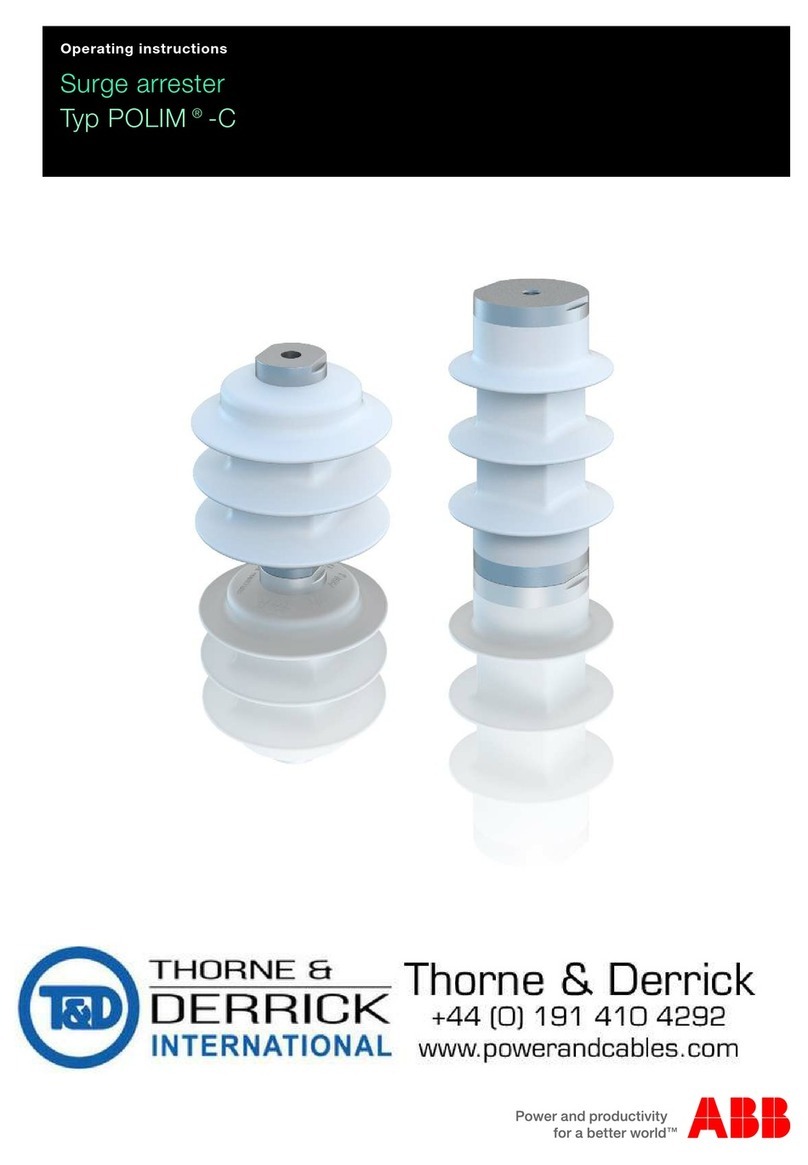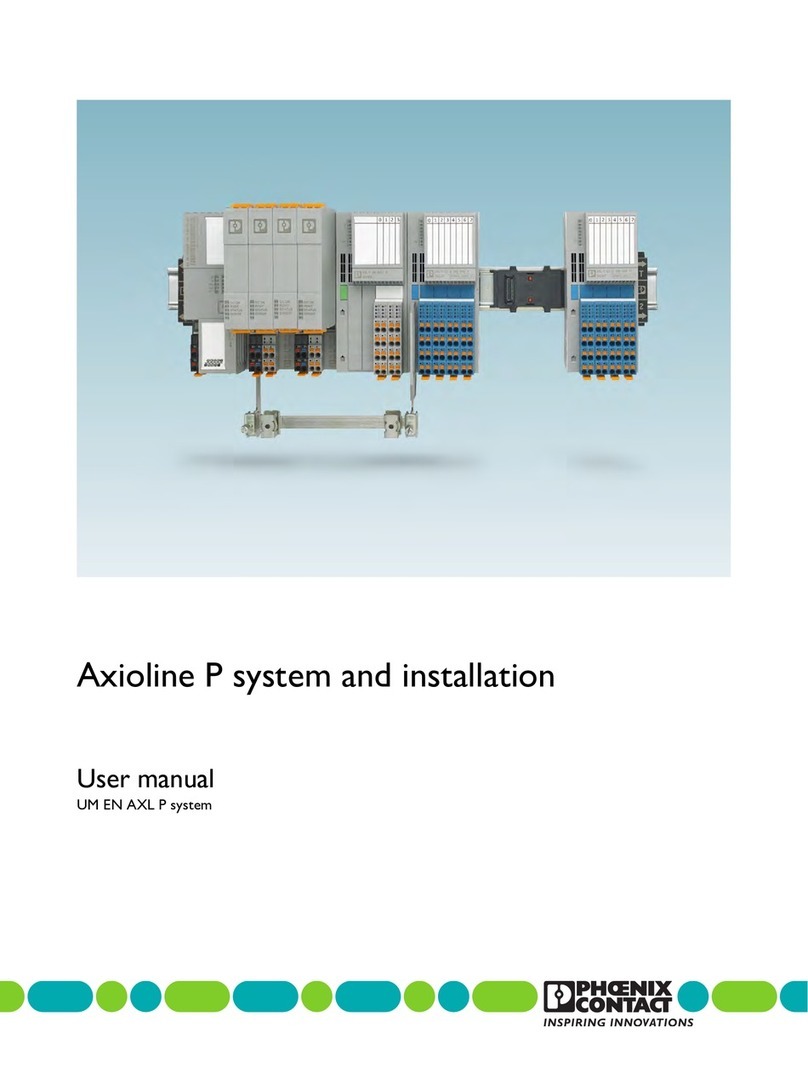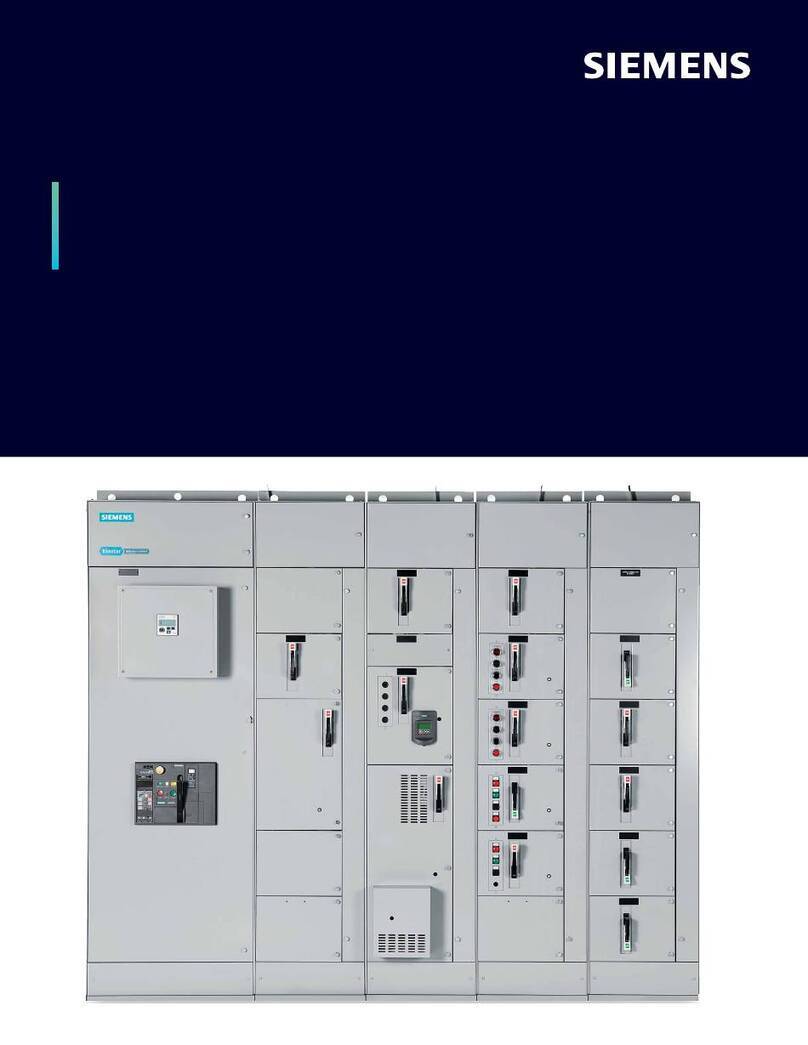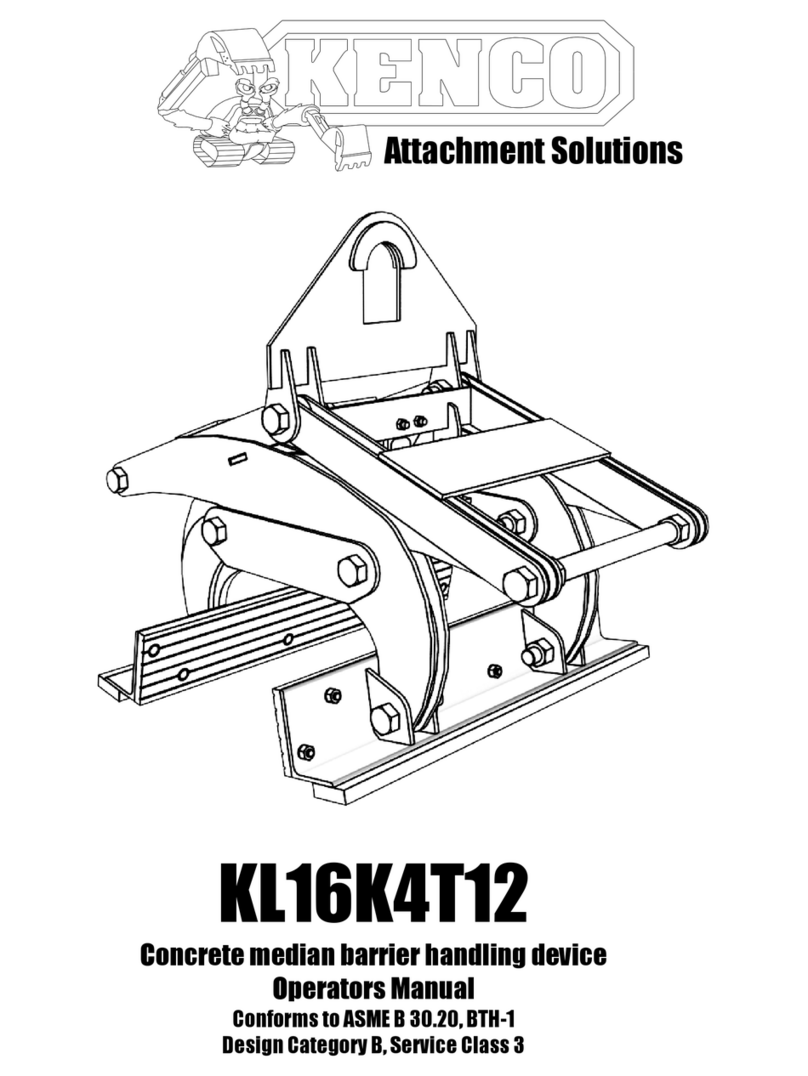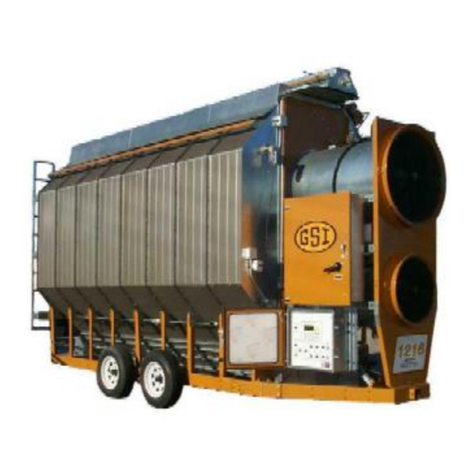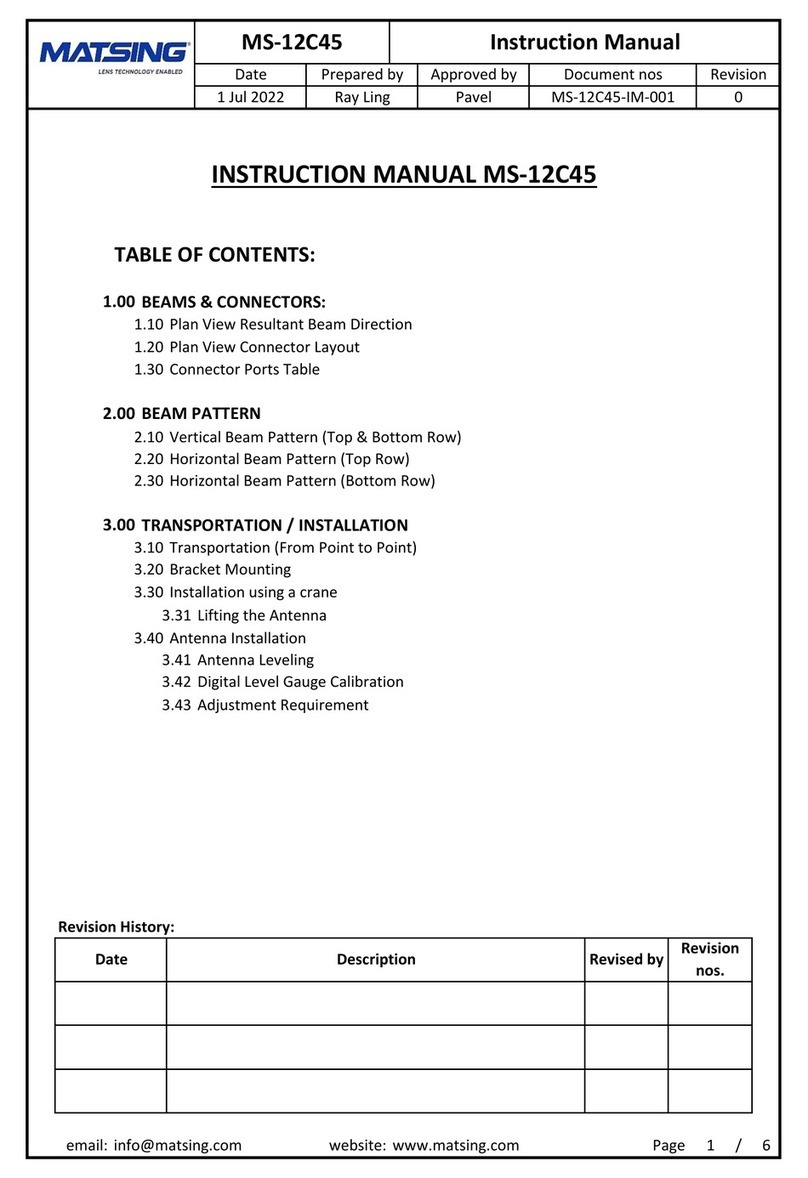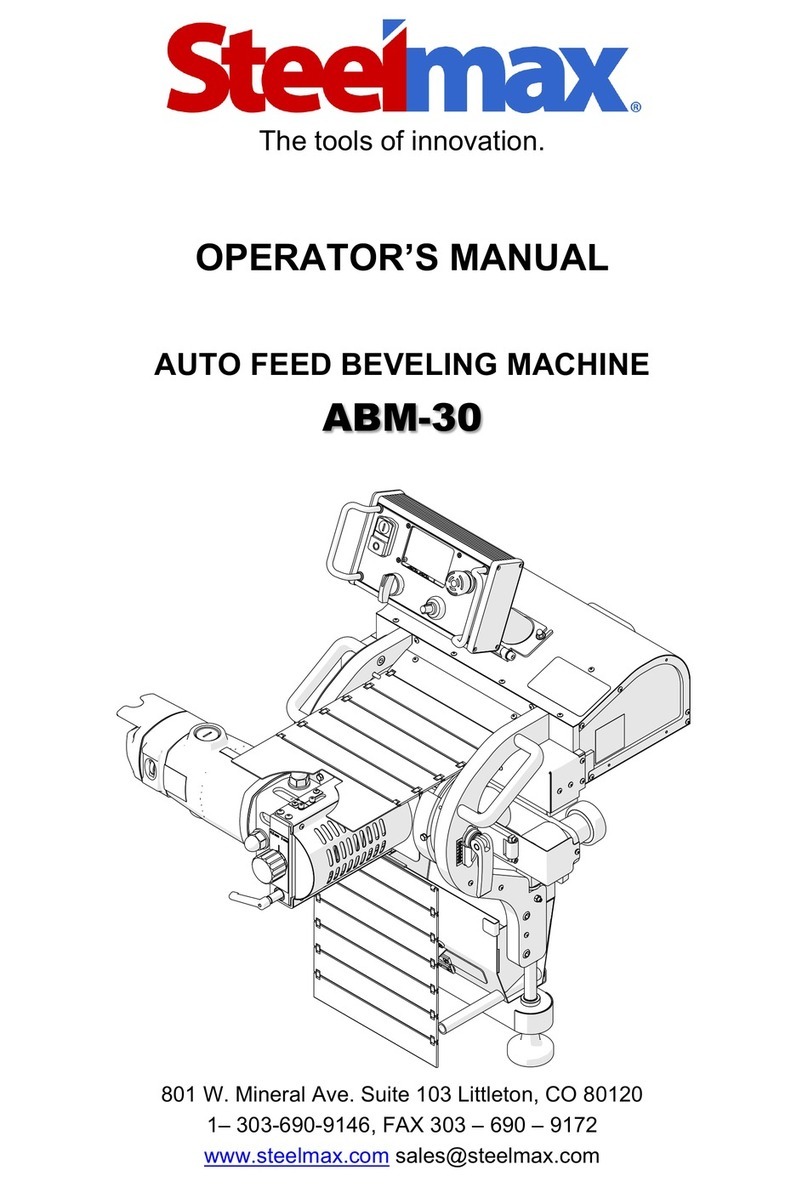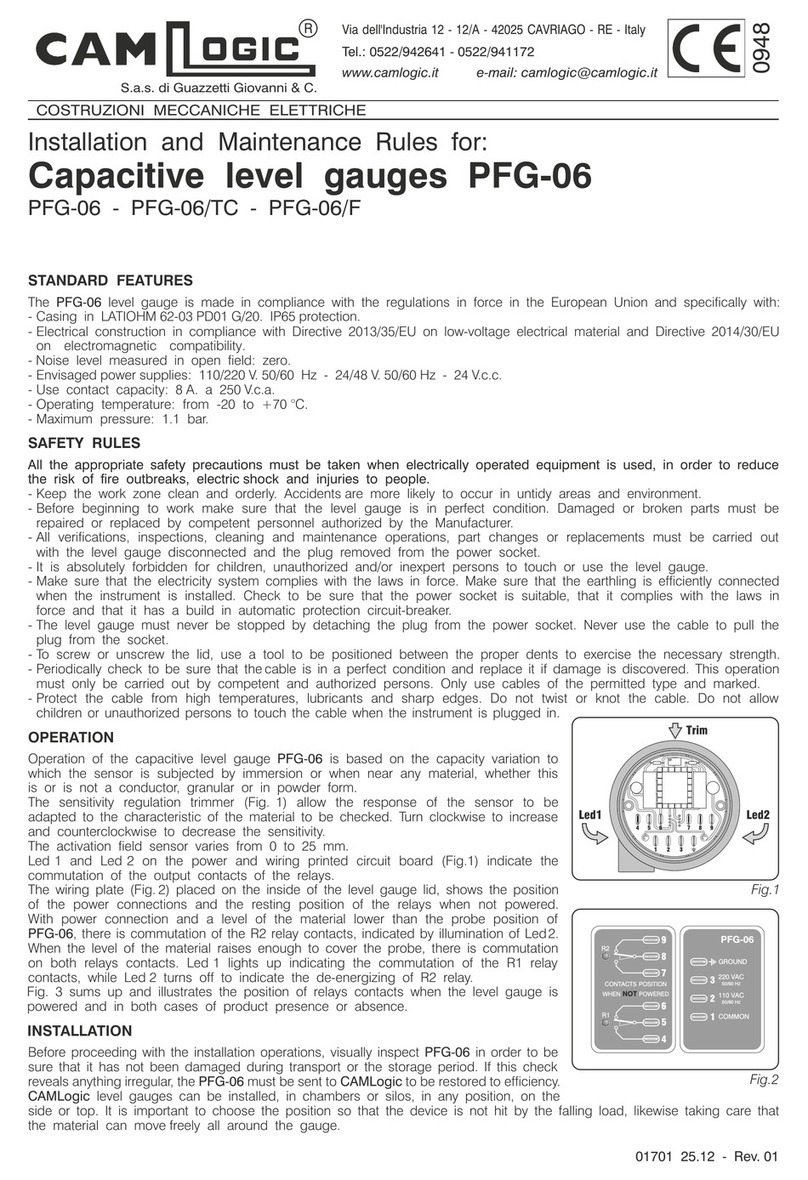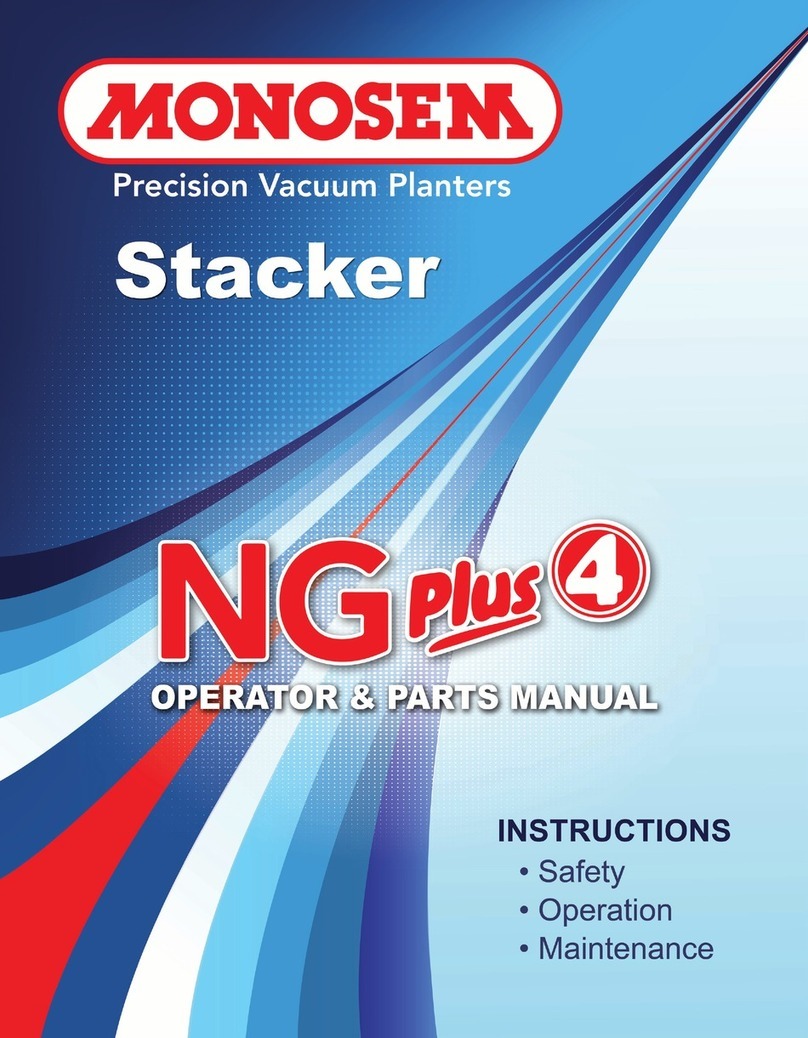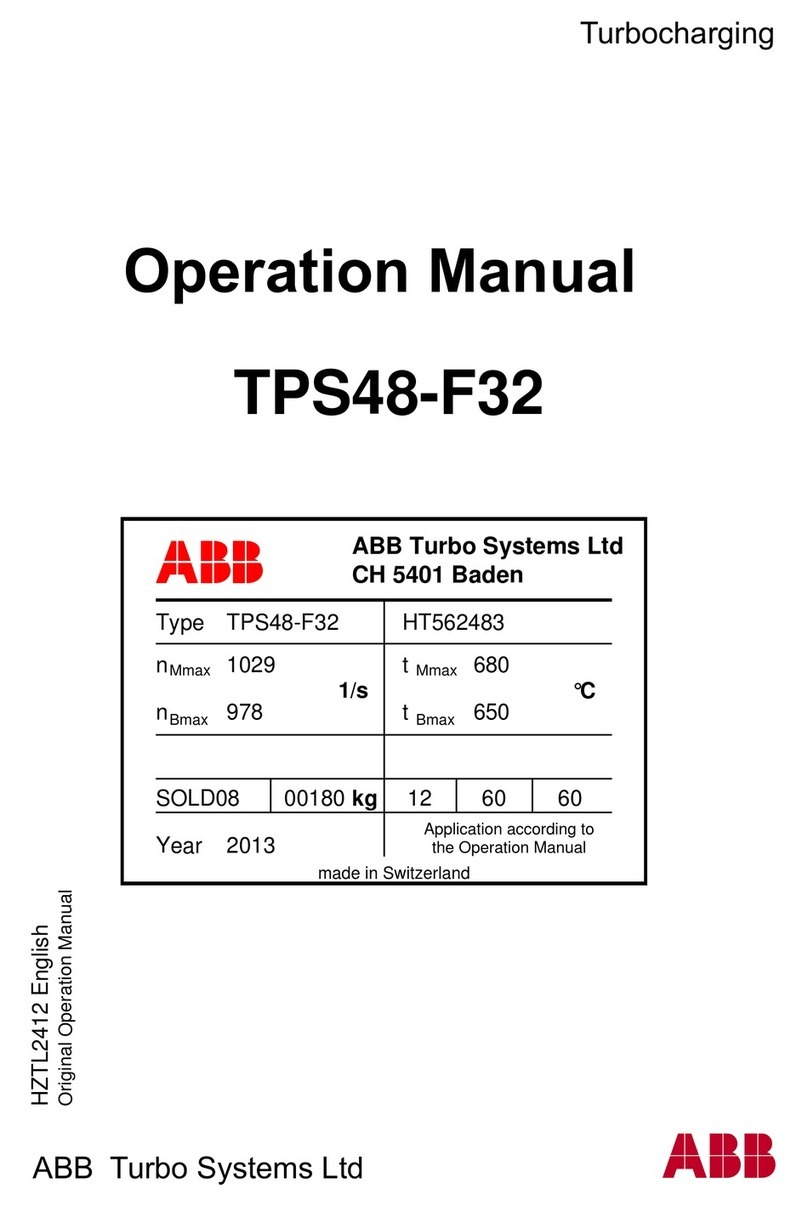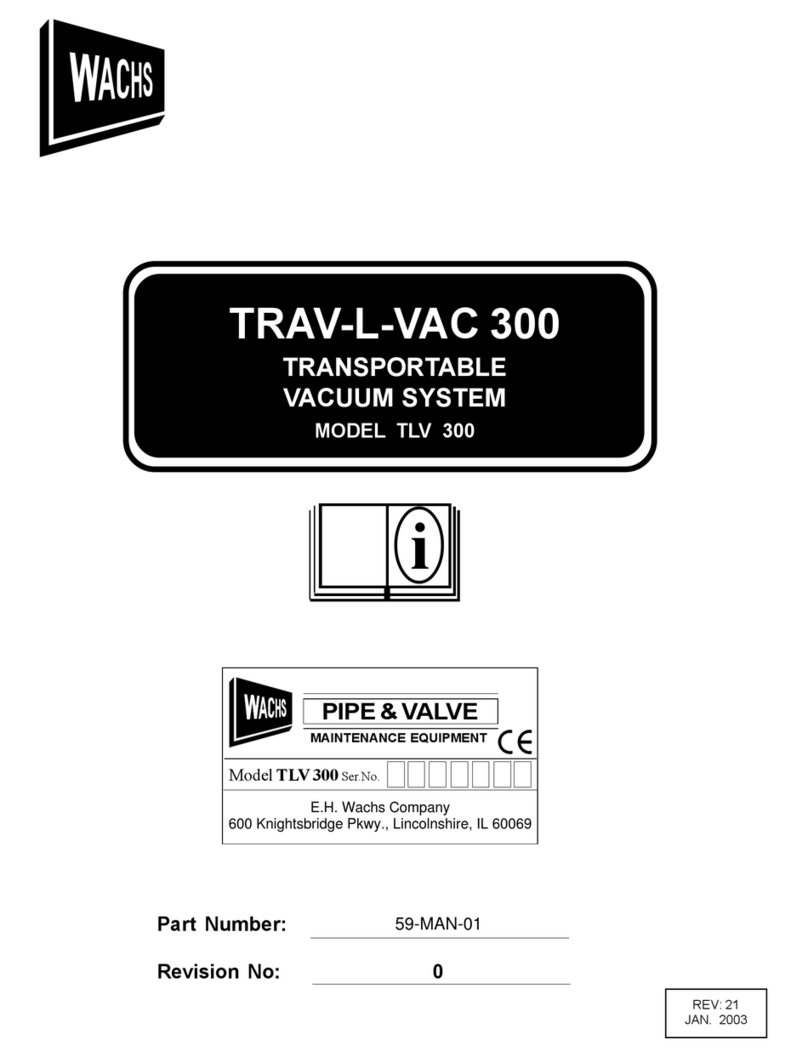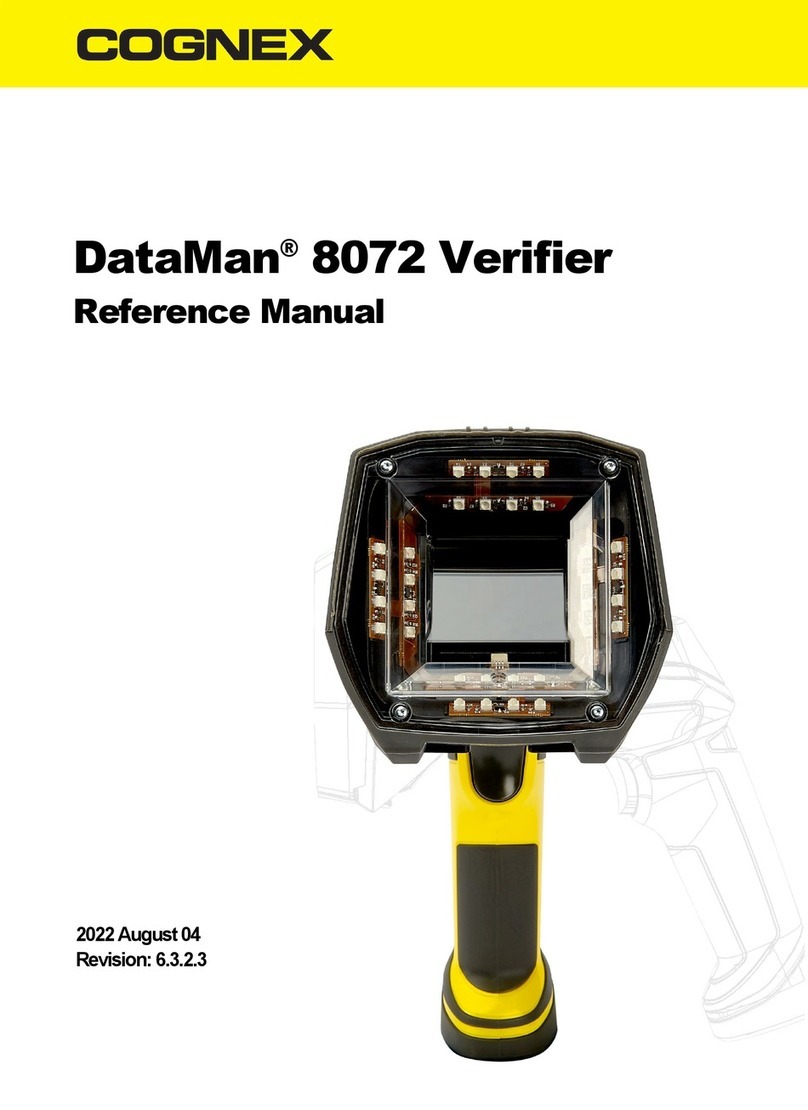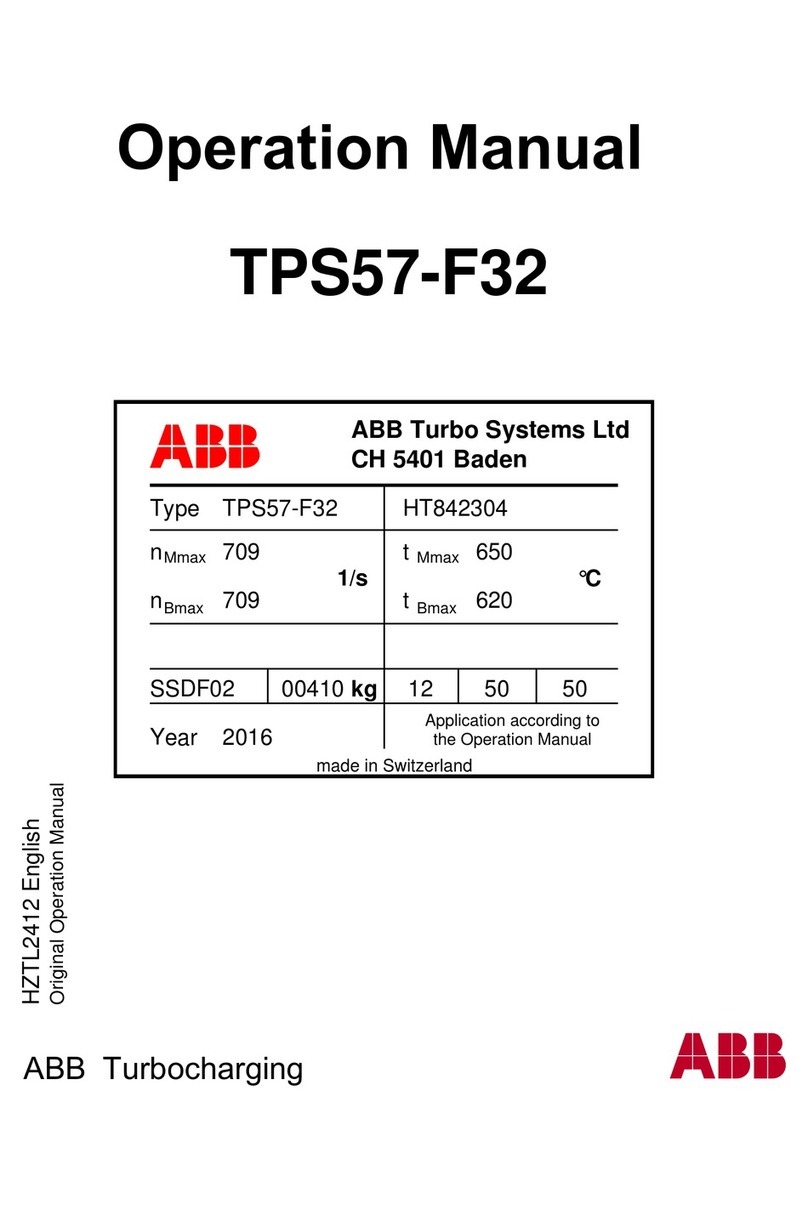Rollsizer Manual Operating instructions

Manual and DC Compact Rollsizer
Operating and Maintenance Manual
All ROLLSIZER.COM products are covered by patents across 48 Countries.
PLEASE READ THIS MANUAL BEFORE YOU CALL ASKING FOR
TECHNICAL SUPPORT.
We at rollsizer.com are always happy to help if you have any questions,
but it is nice to know you have read this first.
Please only use clean cases in the rollsizer. The use of dirty cases in the
rollsizer will wear out the base and disc and is not a warranty claim. We
recommend wet cleaning as dry cleaning can leave dry / dusty residue on
cases which can lead to wear.
The rollsizer and parts are shipped with a Lanolin based coating to
prevent surface rust, yes it looks horrible, but it is the best we have found
to date, clean it off with degreaser or alcohol-based wipes before use.
Please run your DC rollsizer for a minimum of 2 Hours unloaded to bed in
the brushes and gearbox before rollsizing cases. If your rollsizer stalls
when rolling cases, run the rollsizer unloaded overnight. Occasional /
Intermittent stalling WILL occur at first, this is a protection device to
ensure the machine is protected whilst running in.
Yes, the rollsizer will get warm especially when new / running in, this is
normal. Please check your cases are not plated steel, they are hard to
spot. Check with a magnet.

Operating and Maintenance Manual
Contents
Introduction ..................................................................................................3
Safety First.....................................................................................................4
Disclaimer......................................................................................................4
1. Why Rollsize?.................................................................................... 5
2. Why Reload?..................................................................................... 5
3. What are the main steps in reloading?............................................. 5
4. What is supplied with the Rollsizer?................................................. 6
5. DC Compact Operation................................................................... 10
6. Installation...................................................................................... 11
6.1 Casefeeder and Connecting Hose .......................................... 12
7. Processing rates.............................................................................. 14
8. Calibre conversions......................................................................... 15
8.1 Pistol conversions ................................................................... 15
8.2 Calibre conversion process ..................................................... 16
9. Rollsizer operation.......................................................................... 17
9.1 OK, I have rollsized my cases, now what?............................... 18
9.2 My cases do not gauge after rollsizing.................................... 18
10. Why do cases stretch? ................................................................ 21
11. Why don’t you rim roll your cases? ............................................ 22
12. Maintenance, what is required?................................................. 23
13. Pre-Start Checks...................................................................... 24
14. Gearbox and Motor Maintenance .......................................... 25
15. What tools do I need?............................................................. 26
Rollsizer FAQ’s ........................................................................................ 26

Operating and Maintenance Manual
Introduction
The rollsizer you have purchased is a Manual or DC Compact Electric rollsizer
that will supply years of reliable operation if the processes and safety
procedures in this manual are observed.
The rollsizer has been designed to remove the bulge from the base of the
cases, and when combined with a standard full-length sizing die, will result
in a smooth and uniform case sidewall.
Please ensure you read this manual from start to finish BEFORE you use the
rollsizer. Please pay attention to the following key points.
•Only clean, dry, fired (or deprimed) cases should be used in the
rollsizer. Wear on the base / discs are not covered by warranty.
•No case lubrication is required. Case lubrication will compromise
the operation of the rollsizer and allow dirt to stick to the rolling
surfaces. This is the main reason for premature wear.
•The rollsizer process will occasionally leave light marks on the case
from the rolling process this is normal and does not affect the
operation.
•Loaded ammunition or cases with live primers should never be
processed in the rollsizer under any circumstances.
•Check the drop tube height is adjusted before using the rollsizer,
refer to the manual below.
•Only use sorted cases in the rollsizer, whilst it is not likely to
damage the rollsizer, but you will waste a lot of time picking the
cases out. Use long nose pliers, keep fingers clear.
•If you abuse the rollsizer you can damage the rollsizer. This is not a
warranty issue.
•Rollsizing 223 cases will leave a mark on the disc as part of the
rollsizing process. This is normal and expected.
•Fill the clear case tube BEFORE starting the rollsizer.
•Expect the last case in the batch to fall over, they need weight on
them to hold them steady.

Operating and Maintenance Manual
4 | Page Manual and DC Compact Rollsizer O & M Manual
Rev J.docx
Safety First
Please note that with all machinery, safety is critical. Do not allow
inexperienced users to operate this machine and never allow children or
minors near this rollsizer whilst it is operating. Never attempt any sort of
work or adjustment on the machine whilst the rollsizer is energized or
operating. Work should never be done on the rollsizer unless the power
supply is turned off and the power lead is unplugged from the power supply.
Failure to do this could result in significant injury or death as a consequence.
In addition, you should never process reloaded ammunition or cases with
live primers through the rollsizer, if the ammunition or components are
ignited, there is significant risk of injury or death as a result.
Disclaimer
The purchaser and users of this machine expressly acknowledge and hold
harmless, Rollsizer.com Pty Ltd, its affiliates, associates and resellers
(hereafter noted as Rollsizer.com), from all liabilities including loss of
income, injury, harm or death for the use of the rollsizer and any actions that
the use that the rollsizer may have. Rollsizer.com make no claims or
guarantees regarding the suitability of the processed cases for reloading or
any other use and it is the responsibility of the user to verify the suitability
and purpose of the finished product.
All rollsizers are sold subject to the Terms and Conditions on the
Rollsizer.com website.

Operating and Maintenance Manual
5 | Page Manual and DC Compact Rollsizer O & M Manual
Rev J.docx
1. Why Rollsize?
Rollsizing is a case processing method that removes the bulges in the base of
spent cases and allows the ammunition to be reloaded and reused with a
much higher degree of reliability. The ammunition will be more consistent in
quality and time that would be otherwise wasted in case gauging and
wasting loaded ammunition and components can now be used to shoot.
The shooter / reloader can now consider the option of purchasing bulk “once
fired” cases with confidence the ammunition will perform reliably.
2. Why Reload?
The reloading of ammunition is done for a variety of reasons:
•Cost, reloaded ammunition is cheaper than most factory
manufactured ammunition.
•Various shooting sports require ammunition to be loaded with
specific characteristics, factory ammunition is not usually loaded to
suit the specific sport requirements.
•Reloaders will reload once fired or range picked cases and the origin
of this cases may be from oversized or unsupported chambers and
is required to be resized to meet the appropriate specifications.
•The shooter can control the size, specification and quality of
reloaded ammunition to suit their requirements.
•Ammunition can be tailored more easily to suit specific applications.
•Cases can be reused saving time, cost with higher quality than often
available from commercially reloaded ammunition.
3. What are the main steps in reloading?
The steps in reloading are generally as follows; Please consult your loading
manual if you are not sure of the reloading processes:
1. Carefully sort / separate your spent cases checking for damaged,
cracked or unserviceable cases.

Operating and Maintenance Manual
6 | Page Manual and DC Compact Rollsizer O & M Manual
Rev J.docx
2. Clean the cases to remove dirt, stains etc. via tumbling or wet
processing. We do NOT recommend you full length size before
rollsizing. If you want to remove the primers before cleaning use a
universal deprimer only, not a sizing / deprimer die.
3. Rollsize your cases.
4. Reload normally using standard sizing dies (do not use undersized or
small base circle sizing dies).
4. What is supplied with the Rollsizer?
The rollsizer will generally be supplied with the following components in
addition to the calibre conversions purchased with your rollsizer.
1. Your rollsizer is supplied with a drop tube for the calibre conversion.
You will need to install and adjust the drop tube height before use
per the process described in this manual. A Small Pistol Drop Tube
is used for 9mm, 38SC, 357Mangnum and 40S&W. A Large Pistol
Drop Tube is used for 44Magnum and 45ACP.
Rifle conversions are supplied with a calibre specific drop tube in the
conversion kit.
2. Spares supplied for the manual rollsizer include
a. 2 x #5 x ¼” Hex key driver bits for use with a drill
b. 1 x 10mm M6 Socket head bolt
c. 1 x 16mm M6 socket head bolt
d. 1 x oversize washer
e. Length of 16mm (5/8”) ID PVC hose with a Dillon casefeeder
adaptor on one end and a cable tie for the drop tube on the
other end.
3. Spares for the DC Compact Electric rollsizer include
a. 1 x 10mm M6 Socket head bolts
b. 1 x 16mm M6 socket head bolts
c. 1 x oversize washer
d. Length of 16mm (5/8”) ID PVC hose with a Dillon casefeeder
adaptor on one end and a cable tie for the drop tube on the

Operating and Maintenance Manual
7 | Page Manual and DC Compact Rollsizer O & M Manual
Rev J.docx
other end. This hose has been supplied in a length sufficient
for and an under-bench installation.
e. Universal Power supply suitable for 90VAC to 300VAC
supplies. The power supply brick is supplied to the market
as either a molded USA 3 pin plug or with an Australian
power plug and depending on your location a plug adaptor.
Depending on your location you may need to purchase a
plug adaptor to suit your location. These are available from
most electronic and travel stores.
Refer to photographs below identifying the main components of the
rollsizers. The base and conversions are the same for the Manual and DC
Compact.

Operating and Maintenance Manual
8 | Page Manual and DC Compact Rollsizer O & M Manual
Rev J.docx
Drop tube showing
PVC hose correctly
positioned / fitted.
Trim the other end
if you need to
shorten the hose.
Removable Crank
handle. The handle
can be folded away if
not in use or removed
if using a drill.
Mounting holes to
screw base to
reloading bench.
Socket head bolt in the end of
the crank shaft.
Before using a drill to operate
the rollsizer, remove the handle.
Use a #5 Hex driver bit inserted
in your drill to power the
rollsizer.
Manual Rollsizer

Operating and Maintenance Manual
9 | Page Manual and DC Compact Rollsizer O & M Manual
Rev J.docx
Socket head bolt to
adjust drop tube
height and to allow
calibre conversions
to be changed.
Bolt holding calibre conversion
disc.
Calibre Conversion
disc. The conversion
disc must be placed
with the label facing
upwards.
Drop Tube is either Small
Pistol Drop Tube or Large
Pistol Drop Tube.

Operating and Maintenance Manual
10 | Page Manual and DC Compact Rollsizer O & M Manual
Rev J.docx
5. DC Compact Operation
Please note, do not plug in the rollsizer to the power supply until all the
positioning and adjustments of the rollsizer, connecting hoses and all the
ancillary checks have been done. Please ensure all hands, clothing and other
equipment are clear of the rollsizer before plugging the power brick in.
The DC Compact Rollsizer is fitted with a 3-position switch. The positions are
On / Off / Reverse (Momentary). The On switch allows normal rollsizing, the
Reverse switch is a momentary operation which returns to the off position
when released and is designed to allow the rollsizer to be reversed in the
case of a jam or malfunction.
Once the rollsizer is set up and adjusted, plug in the power supply to the back
of the Terminal box and plug in to the wall socket using a plug adaptor if
required. Please note the power brick is a universal power supply and can
accept power supply from 90VAC to 300VAC as well as 50-60hz. The power
supply is fitted with an Australian plug, international customers will require
an adaptor to suit their local requirements.
If the power supply is on and connected to the rollsizer and the switch does
not operate the rollsizer please check the connections and the plug is fully
inserted first. If this does not work, then do not use the rollsizer and consult
with your reseller in the first instance or Rollsizer.com via
info@rollsizer.com.
The power supply block is designed to switch off automatically in the case of
a jam. To restart the rollsizer move the switch to the “Off” position and the
power block will reset itself. The reset may take a few seconds to reset.
The DC motor uses carbon brushes. These brushes occasionally need
bedding in to ensure a good contact between the brushes and the motor
armature in and it is recommended the rollsizer is run unloaded for a
minimum of 2 hours before use.

Operating and Maintenance Manual
11 | Page Manual and DC Compact Rollsizer O & M Manual
Rev J.docx
Yes, the DC rollsizers will run warm, especially when new. This is normal and
the rollsizer can get up to 75 Deg C when new. The rollsizer will cool down
significantly after about 30 hours of operation. If your rollsizer trips out
repeatedly it may need to be run overnight unloaded to bed in the brushes
/ gearbox. This is normal. It is a result of us supplying and oversized gearbox
and motor. It will last a long time, but they do occasionally need time to run
in.
Refer to the FAQ’s
6. Installation
Before you commit to the location of your new rollsizer, please think of the
following key issues.
ON -
FORWARD
POSITION
OFF -
(CENTER
POSITION)
REVERSE -
(MOMENTARY)
DC POWER
PLUG

Operating and Maintenance Manual
12 | Page Manual and DC Compact Rollsizer O & M Manual
Rev J.docx
•How is the tube routed to the Casefeeder when the rollsizer
is in use?
•Does the hand crank of the rollsizer allow full range of
operation and if your hand does not hit any parts for the
press or bench?
•What is the route of the flexible hose between the
casefeeder and the rollsizer? The hose route needs to be
smooth without kinking the hose.
•Can you access the center bolt holding the caliber
conversion disc in this position to allow you to do caliber
conversions without moving the rollsizer?
•Can you see the cases under the drop tube to check the drop
tube is adjusted to the correct height?
•It is recommended the manual rollsizer is bolted or screwed
down to a benchtop before use using the pre-drilled holes in
the base angles. The DC Compact rollsizer does not require
mounting to the bench but has been supplied with pre-
drilled holes in the base angles if required. Simply remove
the rubber feet if required.
6.1 Casefeeder and Connecting Hose
The rollsizer has been supplied with an adaptor and hose to connect to the
standard Dillon™ casefeeder. Refer to photo below.

Operating and Maintenance Manual
13 | Page Manual and DC Compact Rollsizer O & M Manual
Rev J.docx
The adaptor will clip into the casefeeder
where the normal plastic drop tube
connects the Dillon™ casefeeder to the
Dillon™ reloading press. The flexible
PVC hose supplied will connect the
adaptor clip to your rollsizer drop tube.
When the casefeeder and rollsizer
locations are confirmed, check the
route for the flexible hose.
Install the hose end with the cable tie on
it on the drop tube. Run the hose from
the rollsizer to the casefeeder. Insert
the adaptor clip into the casefeeder and
mark out where to cut the hose. The hose route should be smooth and clear
of equipment, allow some extra length in the hose, mark the hose. Measure
and check again before you cut the hose.
To mount the hose onto the adaptor clip, you place the end of the hose in
some hot water for approximately 2 minutes and push onto the hose tail
barbs whilst still hot. Leave to cool whilst holding the hose straight.
In some situations, the hose will have kinked when it is coiled in the box. The
hose can be re-shaped by plugging one end of the hose and filling the hose
with hot water and kneading the hose to re-shape the hose as required. After
the hose is straight and kinks removed drain the water and hang vertically to
cool for 1/2hr.
When not in use, the hose must be hung vertically from one end or left in a
flat position to prevent kinks or bends in the hose. If this occurs repeat the
process above.
The placement of the cable tie on the drop tube end is required to prevent
cases in the hose catching on the end of the drop tube.

Operating and Maintenance Manual
14 | Page Manual and DC Compact Rollsizer O & M Manual
Rev J.docx
In most cases, the end of the hose where it mounts on the drop tube is not
required to be secured, but can be secured if required, using cable ties or
hose clamps (not supplied).
7. Processing rates
The manual rollsizer operating speed will be limited by either the crank
speed you can supply or by the drill speed you use (typically 1,000 to 2,000
cases per hour). Typical case feed rates from Dillon casefeeders are around
1,500 to 2,500 cases per hour depending on their condition and fill amount.
For the Manual rollsizer – hand cranking, we only quote a 400-500 cases per
1/2hr as we doubt you will want to spend more than 1/2hr each time to
crank roll your cases. The effort required to roll cases is minimal, but it is
repetitive. The crank handle is fitted with a foldaway provision to prevent it
catching on clothing when reloading or walking past the rollsizer.
The alternative to the crank handle is to use an electric drill with the supplied
#5 x ¼” hex bit. These are available at most hardware stores if you need
more.
The manual rollsizer is fitted with a socket head bolt screwed into the end of
the crank handle shaft. The bolt is an M6x16mm metric bolt and has a #5
socket head. We have supplied 2 x #5 driver bits in the spares kit.
If you wish to use an electric drill to operate the rollsizer you need to do the
following.
1. Remove the crank handle by removing the cap crew holding the
handle onto the crank shaft.
2. Check the drill is set to screw mode only with the clutch set as low
as possible. Do not use IMPACT MODE. The use of impact mode in a
drill will break the bolt and possibly damage the gearbox. This is NOT
a warranty claim, you have been warned. Any damage to the
gearbox will require the gearbox to be returned to a reseller or
rollsizer.com for inspection.

Operating and Maintenance Manual
15 | Page Manual and DC Compact Rollsizer O & M Manual
Rev J.docx
3. Run the electric drill in low-speed mode, if your drill does not have a
low speed setting, go buy one. If you run the electric drill too fast
and a jam occurs the bolt in the crank handle bolt is likely to break,
this is to protect the gearbox. Removal of the bolt may require
specialist help
It is critical that you do not try to process cases through the rollsizer faster
than the casefeeder can supply reliably and consistently. This will result in
jams. 99% of the problems can be directly related to this.
If you wish to process cases at rates above the capacity of your existing
casefeeder, please contact us at info@rollsizer.com or call us on +61-400-
712-512.
The DC Rollsizer is a fixed speed machine and will process cases around
1,500 cases per hour.
8. Calibre conversions
8.1 Pistol conversions
The calibre conversion for a pistol calibre comprises of 2 basic components
•Calibre specific conversion disc (with the calibre engraved on the
disc)
•Drop tube, there are different types, (small pistol, large pistol and
rifle conversions)
oSmall pistol drop tube covering 9mm, 38S/SC, 357Magnum
and 40S&W
oLarge Pistol drop tube covering 44Magnum and 45ACP
oThe 223 and 308 rifle conversions are supplied with a calibre
specific drop tube.
oAdditional pistol calibres will be released when they become
available

Operating and Maintenance Manual
16 | Page Manual and DC Compact Rollsizer O & M Manual
Rev J.docx
8.2 Calibre conversion process
To change calibre, you need to;
1. Remove any residual cases from the case feeder, check the
casefeeder is empty by running for a short time and listening and
checking for any cases in the case feeder or feed hose.
2. Turn off the rollsizer and unplug the Rollsizer power brick from the
wall socket if applicable.
3. Using a #5 Allen key (not supplied) and loosen the bolt holding the
drop tube. Lift the drop tube approximately 25mm (1”) up and
lightly tighten the bolt.
4. Using a #5 Allen key (not supplied) and remove the bolt and oversize
washer in the center disc. Lift out the disc and store in a dry place.
(If the work area is subject to high humidity, wipe the disc down
with an oily rag to prevent surface rust or place in an airtight bag).
5. With the disc removed wipe down the base assembly with a clean
dry rag to remove any dust or residual dirt or tumbling media etc.
6. Replace it with the new disc ensuring the disc is clean with no traces
of oil or rust preventative. Reinstall the center bolt and oversize
washer, install the bolt finger tight only.
7. If the conversion requires the drop tube to be changed remove the
drop tube by unscrewing the bolt securing the drop tube and
replacing it with the required tube.
8. Check and adjust the drop tube height. Drop 2 cases into the drop
tube and check the extractor groove of the second case is visible,
adjust the height of the drop tube as required. Check the clearance
of the case containment spring as the rifle conversion drop tubes
can interfere with the containment spring. Refer to attached
photograph.

Operating and Maintenance Manual
17 | Page Manual and DC Compact Rollsizer O & M Manual
Rev J.docx
9. When the drop tube is correctly positioned for height, fill the
casefeeder and feed hose.
10. Please note the drop tube must be square to the base. If the drop
tube is not square the cases can fall over. To adjust this, loosen the
bolt holding the drop tube holder, remove it and bend the bracket
in a vice if required.
9. Rollsizer operation
The rollsizer operation is as follows.
•The rollsizer is setup and installed per the above processes.
•Check the drop tube size is correct for the case type and the height
is adjusted correctly.
•The correct calibre conversion disc is installed correctly with label
facing upwards.
•Only clean and carefully sorted cases matching the calibre
conversion are placed in the casefeeder and the casefeeder will then
drop the cases base first into the hose connecting the casefeeder to
the rollsizer.
•Once the rollsizer feed hose is full, turn on the rollsizer, manually
crank or use drill as appropriate.
The full extractor groove
of the case above must
be visible

Operating and Maintenance Manual
18 | Page Manual and DC Compact Rollsizer O & M Manual
Rev J.docx
•The cases will sit on the conversion disc. As the disc rotates, the case
will drop and move sideways pushing the case out from under the
drop tube.
•The next case will drop down and sit on the top of the conversion
disc.
•When the center disc rotates around, the next case will drop and
push out sideways again.
•The cases must sit on the disc for a minimum of 50% for reliable
operation. Occasionally the drop tube holder is bent during
transportation, the drop tube holder can easily be bent back to the
correct shape in a vice.
9.1 OK, I have rollsized my cases, now what?
Once your cases have been rollsized, your normal reloading process can
occur. It is important to note your reloading press may need adjustment.
In most cases, the only adjustment is that the seating and crimp stations will
need adjusting.
It is strongly recommended the reloading process and reloaded
ammunition checked carefully before reloading quantities of ammunition.
9.2 My cases do not gauge after rollsizing
The rollsizing process works on the lower 10-15mm of the case. This is the
section of the case that is unable to be sized in the full-length sizing process.
You must still full-length size your cases.
To complete the case gauging process, the rollsizing process will often
require the reloading press to be adjusted to ensure cases gauge correctly.
We do not recommend the use of undersized dies (small base circle dies)
combined with rollsizing. They are not required and can cause reliability
and feeding problems.
When the cases are rollsized, the cases will lengthen slightly. This is of no
significance as pistol cases usually shrink with repeated reloading, but it is
common for the seating and crimping dies to require adjustment.

Operating and Maintenance Manual
19 | Page Manual and DC Compact Rollsizer O & M Manual
Rev J.docx
Rifle cases will often need trimming, and this should be checked before
reloading.
The following procedure is a process that will assist in establishing the
adjustment required in your reloading press for rollsized cases.
1. Clean and rollsize your cases per the details outlined above using the
correct conversion kit.
2. Full-length size the case in your reloading press. Remove the case
and check again in the case gauge. The case should seat full depth.
3. If the case still does not fully seat, then it is likely the full-length sizing
die needs to be adjusted down. Repeat this step and until the empty
case gauges correctly.
4. Reload the case (without primers or powder) and repeat the process
with a single case. Once this is correctly adjusted repeat with as a
continual process reload 10 or so dummy cases continuously. This
often shows up movement / flexing in the shell plate holder of
some progressive presses.
5. If the dummy cases do not insert fully into the case gauge, the
reloading press dies may need further adjustment, this is normal.
6. To verify where the adjustment is required, remove the dummy case
and place permanent marker lines around the entire round and let
dry.
7. Once dry, place the case inside the case gauge (or chamber check in
your firearm) and twist slightly to make a witness mark on the case.
The witness marks will be visible by scuff marks on the case. These
scuff marks will identify the areas where the cases need adjustment.
Consult your press manual for these adjustments. Please do not do
this with a fully loaded round (I.E., powder and primers inserted into
the round)

Operating and Maintenance Manual
20 | Page Manual and DC Compact Rollsizer O & M Manual
Rev J.docx
Please note that all reloading presses flex to a degree (especially high-end
commercial presses when using fired cases). The settings of the reloading
press should only be considered final once the shell plate assembly is filled
with cases and the press is fully loaded. It is often necessary to adjust the
dies further once the shell plate is full of cases. Rollsizing your cases will
reduce the load on your reloading press to a significant degree.
It is important to note that different manufacturers of case gauges use
different tolerances. There are many case gauges in the market that have
very tight tolerances. The rollsizer.com machine has been designed to roll
cases to meet the mid-range SAAMI specifications with normal sizing dies.
This dimension reflects the typical factory ammunition dimension which is
usually the most reliable and consistent dimension.
This manual suits for next models
1
Table of contents
Other Rollsizer Industrial Equipment manuals
